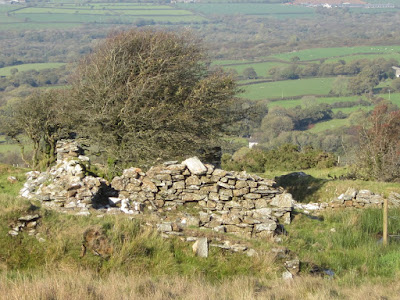I have been looking at these quarries again today -- and I have found another one, on the eastern flank of Banc Du, to the north of Gernos Fach Farm. Like the others, this is a meta-mudstone quarry.
When I put up a post a few weeks ago, suggesting that the quarries are modern, opened up to provide meta-mudstone slabs for building purposes, I was challenged on another Facebook site as follows: "Your hypothesis. You carry the burden of proof. Now prove it!" Perfectly fair and reasonable, since that's what I say to our friend MPP and to various others!
I gave some supporting evidence in my earlier post:
https://brian-mountainman.blogspot.com/2018/09/the-cnwc-yr-hydd-quarries-opinion.html
So we have slabs used in abundance at the ruined cottage called Ffos-felen. Today I looked at the ruined farmhouse at Tafarn y Bwlch, and this is what I found:
As at Ffos Felen, the slabs -- of many different sizes -- are used to level off the courses, given the rough shapes of the erratic igneous boulders used for much of the building.
Then I went off to the top Garfeth Cottage, adjacent to a free-flowing spring, and this is that I saw:
Some of the cottage walls, like the walls at Tafarn y Bwlch, were made of a mixture of dolerite boulders and meta-mudstone slabs, but the wall in the photo above is almost exclusively made of the sedimentary slabs. There used to be mortar, but most of it has crumbled away. (Interestingly enough, this cottage was still occupied in 1946. Our old postman was born in it.)
So there is no point in arguing or speculating any further. The quarries are relatively modern, probably about 200 years old. Maybe some of them were used earlier, maybe back to the Middle Ages, for the building of cottage walls -- and I suppose there is a possibility that there was some exploitation in prehistoric times as well -- given that the slabs are very easy to extract from the ground and to carry away. Another factor is the relatively dry nature of the ground underfoot -- this is dry heath and not peat bog, so the going is pretty good, even in the middle of winter. All of the quarries are easily accessible with horse-drawn carts and sledges, and many of these wide tracks can still be traced on the ground and on satellite images. And a final factor -- all of the quarries are located high up on the hillsides and near the hill summits, so transport of the stone slabs from quarry to building site was always downhill. Easy!
Since the last great phase of building in this area, around the fringes of the commons, was after the Napoleonic Wars, I would date the creation of most of these quarries to the period 1810-1830.
M'Lud, I rest my case........





No comments:
Post a Comment